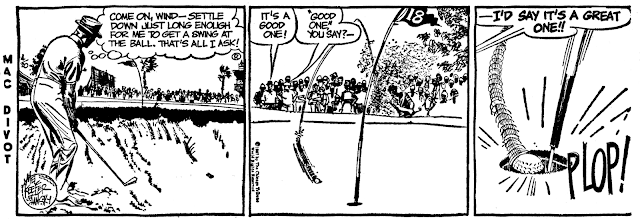Monday, July 29, 2024
Under The Radar: Mac Divot
 |
 |
Mac Divot was a true original in newspaper comics; a serious continuity feature about a golfer. Golf was no stranger to comics at all -- earlier entries included The Dubbville Foursome, In The Rough, The Meadowlarks and others. But they were all played for laughs.
But in 1955 creators Jordan Lansky, writer, and Mel Keefer, artist, noticed that while there were successful strips about baseball and boxing, other sports were for the most part unrepresented. Since both were avid, if not expert, golfers, they decided they might just have the perfect timing for a serious golfing strip.
In the earlier 1900s golf had been a popular sport, but then the Depression and World War II put the damper on it. In the 1950s, though, Americans were once again beginning to enjoy more leisure time, and the economy was on the upswing. Golf became a newly popular way to spend both time and money. And then in 1954 an exciting young phenom named Arnold Palmer won the U.S. Amateur and created for golf another type of fan, the armchair golf aficionado glued to his or her TV all weekend.
U.S. newspapers were generally slow at cluing in that golf was becoming important to readers, and now were caught searching for interesting golf content. Syndicates were similarly slow on the draw at creating it for them. Lansky and Keefer were perfectly positioned to jump into that void, and the Chicago Tribune-New York News Syndicate wisely put these creators under contract when they brought the idea to them.
With a few quick tweaks to the original concept the new daily-only strip was rushed out on April 18 1955*. The initial client list was very impressive, with some starry-eyed reports putting it around two hundred papers (E&P reported a more down to Earth 22). Compared to the general market for continuity strips, which was pretty well glutted at this time, that kind of debut was a notable achievement, even if the true number was just 22. Some client papers put Mac Divot on the comics page, but most wisely added him into their sports sections where it was more likely to find an appreciative audience.
The strip's plot was reasonably simple; Malcolm Mac Divot is the golf pro at Grassy Knolls Country Club, and his early-20s age son Sandy Mac Divot is a gifted golfer looking to make his mark on the circuit. Throw into the mix a love interest for Sandy in Marla Brooks, and things were off to the races. The strip concentrates mostly on Sandy going to tournaments, following the golf play with loving detail (or excruciating detail if you're not a golf fan). Sandy wins in skin-of-the-teeth fashion practically all the time amid improbable dramas and incredible shots on the links. Father Malcolm acts as the wise sage giving Sandy, and readers, words of golfing wisdom when the crises loom. In between tournaments, we meet various characters at Grassy Knolls, all of whom need the ministrations of Malcolm to improve their games.
The strip originally strove to offer not just golf action but off-the-links drama as well, especially regarding Sandy's romance. It was soon realized, though, that the strip's audience was not especially keen on soap opera, and Sandy's love life was all but forgotten. Girls out of the way, Mac Divot was pretty much wall-to-wall golf from then on, with practically all the drama confined to the course.
An interesting aspect of the strip was that as Sandy became a world-class golfer, the creators decided that instead of making up fake tournaments for him to win, they'd have him play in real tournaments and rub elbows with the real leading lights in golf. Keefer's ability to draw recognizeable famous faces became another big plus, as golf fans could hardly pass a comic strip by if they saw Jack Nicklaus or Billy Casper making an appearance. The tournaments had their real names, but Sandy Mac Divot's exploits at them were, of course, entirely fictional. And so while famous golfers strolled through the strip constantly, readers never got to see Sandy beat the pants off Gary Player at the U.S. Open, but rather fictionalized equivalents.
The Mac Divot comic strip cruised along with a decent number of papers, and new clients seemed to generally compensate, or even outnumber, cancellations. Client papers tended to stick with the strip over the long haul, showing an evident reader appreciation. But in 1973 the Chicago Tribune dropped the strip from their own pages, and that's seldom a good sign. Despite what seems like a still reasonably healthy client list, the strip retired to the 19th hole on February 2 1974**, falling just short of the two decade mark.
If Keefer or Lansky ever explained why the strip was cancelled, I can't find it. Has anyone got the straight skinny on this unexplained end to a reasonably popular strip?
* Source: Chicago Tribune.
** Source: Tampa Times.
Labels: Under The Radar


















